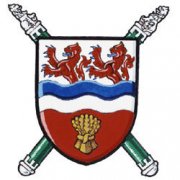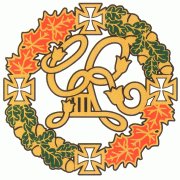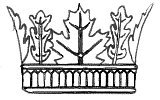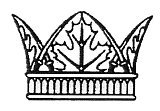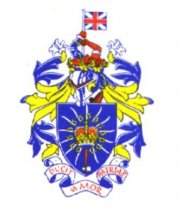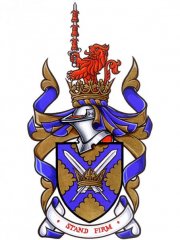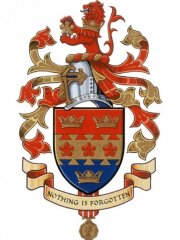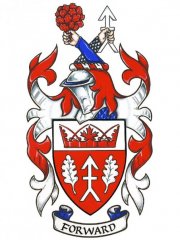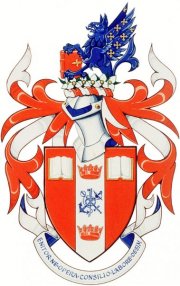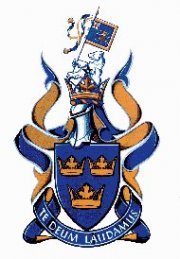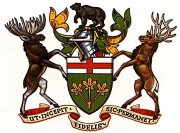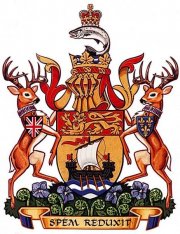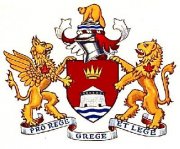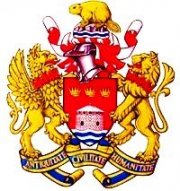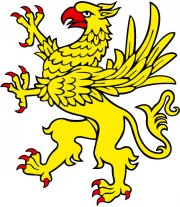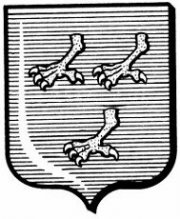Mr. Speaker & the Loyalists
by Brian de Fitz-James; 31, October, 2008
On November 18th, 2008, Peter Milliken, the Member of Parliament for Kingston and the Islands since 1988, was re-elected Speaker of the House of Commons. Mr Milliken's Armorial Bearings, which are shown at the head of this note, were granted by the Canadian Heraldic Authority in 2004. The Arms are blazoned as "Per fess Argent and Gules a fess wavy per fess wavy Azure and Argent, in chief two demi lions Gules issuant from the fess, in base a garb Or", and the Crest is blazoned as "issuant from a Loyalist military coronet Or a demi lion Gules holding the Mace of the House of Commons of Canada Or". The Supporters are "two griffins Or each gorged with a Loyalist military coronet Gules and standing on a grassy mound Vert". The motto is "Je regarde bien", meaning “I look carefully”; it echoes the traditional motto of the Milliken family in Scotland, “Regarde bien”.
The Arms are based on those assigned by the Lord Lyon King of Arms to Milliken of that Ilk, and the Loyalist military coronet of the Crest symbolizes Mr Milliken’s heritage as United Empire Loyalist; he is a descendant of Charles Rose, who fought in the American Revolutionary War in the King’s Royal Regiment of New York. The mace in the Crest is the traditional symbol of the authority of the House of Commons. The supporters are a reference to Kingston: a griffin is one of two supporters in the City’s Armorial Bearings. Mr Milliken’s Loyalist military ancestry is underlined through the use of the coronets on the Supporters. Above this paragraph may be seen the shield of the Arms of Peter Milliken placed on two representations of the baton of Office of the Speaker of the House of Commons. This baton of Office is carried by Mr Speaker on ceremonial occasions such as the State Opening of Parliament.
The American Revolution and the United Empire Loyalists
The American Revolution shattered the British Empire in North America, but not all of the inhabitants of the Thirteen Colonies opposed Britain. A significant proportion of the population, estimated at twenty to thirty percent, was determined to remain loyal to the Crown and desired to remain within the British Empire. The reasons were as varied as the people themselves, but the overriding principle was loyalty to the King. The Royal Cypher of King George III is included in the Badge of the United Empire Loyalists, shown in the margin of this paragraph; the Loyalists were those colonists whose steadfast allegiance to the Crown resulted in persecution, loss of property and forced emigration after the American Revolution. Loyalists began leaving at the end of the war whenever transport was available. An estimated 70,000 Loyalists, approximately 62,000 of them white and 8,000 black, representing about three percent of the total American population, left the thirteen newly independent states; 46,000 fled to Canada. These Loyalists additionally included many of the Aboriginal people who had fought alongside the British; thousands of Iroquois and other pro-British Aboriginals were expelled from New York, and other states, and resettled in Canada. One such group of 2000 Iroquois were led by Joseph Brant, The Grand Chief Thayendenegea, to the safety of Crown land which was given to the Loyal Haudenosaunee out of gratitude; today part of those lands form the Six Nations of the Grand River, the largest First Nations territory in Canada.
Present-day descendants of those original refugees comprise an estimated ten percent of the population of Canada, and may apply the term United Empire Loyalist to themselves, and may also use "UE", for Unity of Empire, as postnominal letters; the honorific is one of few hereditary honours in Canada. They are also entitled to the use of special coronets within their Armorial Bearings, if Arms are granted to them. There are two versions of the Loyalist coronet, both illustrated above this paragraph. The civil coronet is made up of alternating oak and maple leaves, and the military coronet is made up of maple leaves alternating with crossed swords. The right to use the United Empire Loyalist coronets is established by the Canadian Heraldic Authority according to the regulations of the United Empire Loyalists' Association of Canada. A petitioner for Arms who wishes to have either or both types of Loyalist coronet in their Armorial Bearings must first provide proof of Loyalist heritage to the Canadian Heraldic Authority before permission is granted; the only proof recognized by the Authority is a numbered certificate from the United Empire Loyalists' Association that says the petitioner is descended from a specific Loyalist or Loyalists.
Any descendant of a United Empire Loyalist may become a member of the United Empire Loyalists' Association of Canada, a heritage organization founded first as an Ontario body corporate in 1897, and then as a federal institution in 1914. The Association's Coat of Arms, granted by the English College of Arms in 1972 and confirmed by the Canadian Heraldic Authority in 2004, is shown above this paragraph. Petitioners to the Canadian Heraldic Authority who wish to be recognized as United Empire Loyalists must provide proof of each generation between themselves and their Loyalist ancestor. Descent through either male and female ancestors, by birth or by adoption, is the only qualification for recognition as a Loyalist. It is not necessary to be a member of the United Empire Loyalists' Association to be a UE, as it is an inherited honorific. The ancestor, to be recognized as a Loyalist, must have left the American colonies to settle in Canada between 1776 and 1789; both male and female Loyalists, and those of all races and religions, are recognized.
Some Recent Canadian Grants of Arms to United Empire Loyalists
There is no limit, other than good heraldic taste, to the number and type of Loyalist coronets that may be used in their Armorial Bearings by those recognized as United Empire Loyalists, regardless of the number or status of their Loyalist ancestors; they may be used in both the Arms and the Crest, as well as in the Badge and in the Supporters, if these are granted. The topmost of the Armorial Bearings above was granted to George Anderson in 2000. The shield shows two quill pens in saltire, enfiling a Loyalist military coronet, and the Crest includes a Loyalist civil coronet; the lion and sword impaled with three chess rooks are taken from the crest of Michael Van Koughnet, the first of Mr Anderson’s Loyalist ancestors, who settled in Canada in the early 1780s.
In 2002 the Canadian Heraldic Authority granted Armorial Bearings to David Rumball, the descendant of three United Empire Loyalists. His Coat of Arms, shown second from the top, includes a dovetailed fess between three Loyalist military coronets; the Crest is s demi lion Gules gorged with a Loyalist military coronet and holding between its paws a cinquefoil Or. Mr Rumball's motto, "Nothing is forgotten", is a reminder to remember one’s heritage and values. The Canadian Forces Decoration is suspended beneath the shield.
Next are the Armorial Bearings of David Kelsey Dorward, granted by the Canadian Heraldic Authority in 2004. Between two oak leaves is the heraldic symbol of the Kościesza clan, an arrow fourché, head in chief, conjoined with a billet fesswise; on the chief of the Arms is a United Empire Loyalist military coronet. The military coronet represents Mr Dorward’s descent, through his mother’s line, from Abraham Coons of the Loyal Rangers Regiment, known as Jessup's Rangers. The Polish clan symbol for Kosciesza also appears in the Crest, and is that used by the family of Mr Dorward’s wife, Diana Janosik-Wronski. Note that motto rhymes with Mr Dorward's name.
Professor Reginald Land's Coat of Arms, granted in 1995, is blazoned "Gules on a pale Argent between in chief two open books Proper bound Or a sword point upward and a foul anchor in saltire surmounted by a calumet in pale bowl upward all interlaced with a chaplet of olive leaves Azure between two Loyalist civil coronets in pale Gules". The two coronets represent Professor and Mrs Land, who are both the descendants of United Empire Loyalists. The Aboriginal pipe, sword and anchor emblem between the coronets was designed by Governor Simcoe as part of the Great Seal of Upper Canada from 1792 to 1841.
The Armorial Bearings of Arthur Potts are the last of those in the group above. The three Loyalist military coronets on the shield reflect his Loyalist military ancestry in three separate family lines; his Crest includes a fourth military coronet. As these recent heraldic examples demonstrate, the influence of the Loyalists on Canada remains strong. Their ties with Britain, and their antipathy to the United States, provided the strength needed to keep Canada independent and distinct in North America; the Loyalists' basic distrust of republicanism influenced Canada's gradual path to independence. The provinces of Upper Canada-- now Ontario-- and of New Brunswick were created as places of refuge for the Loyaliists, and the mottos of the two provinces reflect this history. Ontario's motto is "Ut incepit fidelis sic permanet", meaning "loyal she began and loyal she remains"; New Brunswick's motto is "Spem Reduxit", meaning "hope restored".
Below are the Armorial Bearings of the Queen in Right of Ontario and of New Brunswick; both provinces were granted their Coats of Arms upon the confederation of Canada in 1867.
Postscript: The Griffin of Frontenac,
Kingston and Milliken
In 2000 the city of Kingston was granted new Armorial Bearings to mark its amalgamation in 1998 with Fort Henry and Fort Frederick. The single antique crown on its old Arms was replaced with three such crowns, mirroring the three crowns in the arms of the city's namesake, Kingston-Upon-Hull; the single red maple leaf on the Supporters became collars of three maple leaves. The motto was changed from "Pro rege grege et lege", meaning "for the king, the people and the law", to "Antiquitate civilitate humanitate", freely translated as "a civil and creative community with a proud past". The round Martello tower that is the main charge on the Coat of Arms is an outstanding feature of Kingston's waterfront, and has symbolized the City for almost two hundred years. The Crest refers to the original name of Cataraqui, derived from the Aboriginal word meaning "rocks rising from the water". Kingston was chosen as the first capital of the united Canadas, and served in that role from 1841 to 1844.
Louis de Buade, Comte de Frontenac et de Palluau, was Governor General of Canada from 1672 to 1682 and from 1689 until his death in 1698. He founded Kingston in 1673 as Fort Cataraqui; it was later renamed Fort Frontenac in his honour. The count's Coat of Arms was Azure three griffin claws Or, as illustrated in the final drawing in this note; the Supporters of his Armorial Bearings were two golden griffins, and it is interesting to note that these same fabulous beasts have since found their way, via Kingston's griffin Supporter, to the Armorial Bearings of Mr Milliken, Speaker of the House of Commons.

